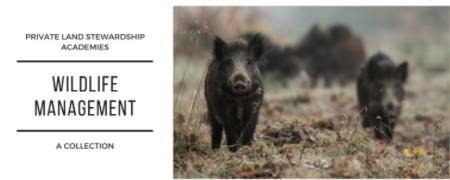The Texas A&M Natural Resources Institute, NRI, a part of Texas A&M AgriLife, has released its second collection of its Private Land Stewardship Academy series, with this collection focusing on wildlife management.
The Private Land Stewardship Academy collections are made up of interactive publications developed from materials created by NRI and its project partners during face-to-face training and presentations. They are part of an effort to build a community of practice around land stewardship for outdoor enthusiasts and private landowners alike.

These private land stewardship publications are meant for everyone from the classroom to the field. They meet the learner where and how they want to explore the information.
Collections are composed of videos that teach processes, story maps that walk readers through a visually rich narrative, websites for learning, interactive coursework with quizzes and more.
Since the launch of these interactive publications, NRI and its project partners have banded together to recreate education so that it can be available in new ways. These virtual publications came about as an effort to take existing materials from previous presentations, from flash drives or publications collecting dust on shelves, and shake them up so anyone in the world could access them.
Interested stakeholders can find and share these anytime — click, open, explore, shuffle through the content and save up the information. Participants can quiz their knowledge gained at the end, making them a great component for classrooms and youth learning environments especially.
This collection is one of four planned collections of the Private Land Stewardship Academy series. The first collection focused on natural resource management.
Collection Two: Wildlife Management.
The following are the 11 resources of the second collection of the Private Land Stewardship Academy series:
- Interspecific Competition Between Invasive Wild Pigs and White-Tailed Deer: This interactive vignette provides a research-based overview of the potential impacts that wild pigs have on white-tailed deer through interspecific competition.
- Field to Table Safety Precautions for Wild Pigs: In this stewardship vignette, NRI breaks down the precautions necessary to manage land for wild pigs, as well as how to handle, process, prepare and preserve these animals for human consumption.
- Exclusion Fencing for Wild Pig Management: Participants can explore the various types of exclusion barriers and how they can restrict the movements of wild pigs in this stewardship deck.
- Wild Pig Biological and Behavioral Drivers: This interactive lesson explores some of the most common drivers of wild pigs. By evaluating these drivers, control strategies can be selected and refined to increase the success of abatement efforts.
- Differences Between Wild Pigs and Javelinas: Learn the visual, behavioral and biological differences between wild pigs and javelinas. The resources aim to increase the understanding of wild pig biology, natural history, damage management and control techniques.
- Getting to Know the Texas Quail Atlas: Interactive maps and ecoregion case studies make a great resource for landowners and wildlife enthusiasts interested in learning more about Texas quail history, the changes across landscape for quail habitat and the places where they thrive.
- The Habitat Requirements of Texas Quails: A story map outlining the four quail species that call Texas home and their specific habitat needs. Landowners need to know the specific habitat requirements of each locally occurring species of quail to help reverse quail population declines.
- Sounds a Quail Makes: An entertaining audio lesson where participants listen to birdsongs and calls, learn the difference between the two types of sounds and why they are important.
- What Do Quail Eat?: This stewardship lesson provides a comprehensive overview of a quail’s diet, from arthropods to forbs and grasses to woody plants.
- The Anatomy of a Quail: In this interactive lesson participants can explore the internal and external anatomy of the bobwhite quail to help inform future land and wildlife management decisions.
- About the Western Chicken Turtle: Participants can brush up on their turtle facts while learning more about where the western chicken turtle lives, what it eats, how to identify it, and current and previous conservation efforts to help ensure its long-term survival on private land.
Source : tamu.edu